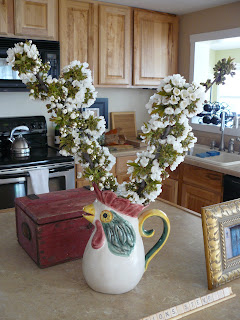
 I thought you might enjoy seeing pictures of the wonderful leafy greens in our vegetable garden. All of this survived the winter. We have enjoyed a veritable vegetable bounty since mid January! Most of the plants were set out in November and then ignored. I had great intentions. I didn't intend to ignore them but the Christmas holiday preparations and two long and unplanned road trips precluded any significant time investment in our garden.
I thought you might enjoy seeing pictures of the wonderful leafy greens in our vegetable garden. All of this survived the winter. We have enjoyed a veritable vegetable bounty since mid January! Most of the plants were set out in November and then ignored. I had great intentions. I didn't intend to ignore them but the Christmas holiday preparations and two long and unplanned road trips precluded any significant time investment in our garden.In addition to what you see here, the kale, onions, a few artichoke plants and a variety of herbs also braved the cold months and are currently thriving. I think this survival rate, at least for the tender greens, is somewhat unusual thus my plan for this year is to winterize the garden in the late fall. I may even be able to grow a few things in the green house that we are currently building. Fortunately winter 2011 didn't bring the cold of winters past, at least not for multiple days on end. Therefore the tender plants weren't devastated by a constant freeze/thaw cycle. This was a real bonus for us since we weren't here to baby them along.
I rarely pull up an entire bunch of anything green. I use my clippers to remove the amount of leaves I need and I cut from each plant rather than clipping just from one. This is a great way to harvest because the plants will just continue to produce new growth and the yield per plant is much greater.

I will share with you my favorite way to prepare the greens. You may have a preferred method but this is what I like to do~
First, snip a generous basketful of greens. Use a variety of whatever you have growing. If you are buying rather than harvesting then I suggest rainbow Swiss chard, spinach, kale (red or green) and a nice handful of fresh chives. Clean all of your leafy greens well. This takes a little time. I always leave my greens soaking in the sink for about 15 minutes. Then I run the leaves individually under tepid water to make sure that I have removed all the grit and dirt.
While your greens are soaking, rinse the chives and dice them rather finely. Along with the chives, I love to add minced fresh garlic. Saute the chives and garlic in about 3 Tablespoons of olive oil until just wilted. After your greens are thoroughly cleaned and patted dry, roughly chop them up, discarding the fibrous lower stems. To prepare the kale you will need to cut the leaves from the center stem all the way up. The stems of kale are just too tough and they don't get tender in the cooking.
When you have finished preparing the greens, add them to your chives and garlic. Saute them briefly over medium heat until they are just crispy tender. Don't over cook them. If the saute appears to be too dry you might want to add a little additional olive oil or a little organic chicken broth
Finally, add some very high quality sea salt to taste and serve. I guarantee that you won't be disappointed. In my opinion sauteed greens far surpass steamed. You might even fool a finicky eater!
You can also use these dense leafy greens in soups. My mom makes a wonderful soup with sweet potatoes, kale and coconut milk. If you like to eat raw you might try topping your greens with an olive oil and rice vinegar dressing. Just throw in some chives or onion, a crispy organic apple roughly diced, a handful of pecans and some shredded asiago cheese and you have a delicious main dish salad loaded with essential phyto-nutrients.
Because the vegetables with the darkest and most intense color have the highest nutrient content, the dark leafy greens are a prescription for great health. That's why they're growing in our garden. And best of all, with careful harvesting these plants will just keep on giving.
Let me know which leafy vegetables you love and how you like to serve them. I would especially enjoy hearing about your own vegetable gardening experiences!
Looking forward to your comments...
A Post Script: Tonight's dinner! A melange of greens sauteed in olive oil with green onions, roasted garlic, pecans and fresh sheep's cheese. Spicy chicken sausages round out the meal.














